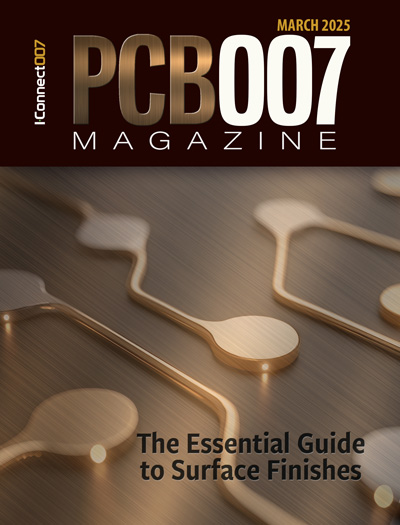-

-
News
News Highlights
- Books
Featured Books
- pcb007 Magazine
Latest Issues
Current Issue
In Pursuit of Perfection: Defect Reduction
For bare PCB board fabrication, defect reduction is a critical aspect of a company's bottom line profitability. In this issue, we examine how imaging, etching, and plating processes can provide information and insight into reducing defects and increasing yields.

Voices of the Industry
We take the pulse of the PCB industry by sharing insights from leading fabricators and suppliers in this month's issue. We've gathered their thoughts on the new U.S. administration, spending, the war in Ukraine, and their most pressing needs. It’s an eye-opening and enlightening look behind the curtain.

The Essential Guide to Surface Finishes
We go back to basics this month with a recount of a little history, and look forward to addressing the many challenges that high density, high frequency, adhesion, SI, and corrosion concerns for harsh environments bring to the fore. We compare and contrast surface finishes by type and application, take a hard look at the many iterations of gold plating, and address palladium as a surface finish.
- Articles
- Columns
Search Console
- Links
- Media kit
||| MENU - pcb007 Magazine
Estimated reading time: 1 minute
Why is Rigid-Flex So Expensive?
One question that I hear fairly often, particularly after an initial quotation, is “Why is rigid-flex so expensive?” In this column, I’ll share with you the cost drivers in rigid-flex relative to standard rigid boards and flex circuits with stiffeners. A typical rigid-flex PWB will cost about seven times the cost of the same design on a hard board, and two to three times an equivalent flex circuit with stiffeners. A good way to estimate the cost of rigid-flex board in low-level production quantities is 35 to 40 cents per square inch, per layer. So, if you have an eightlayer board that measures 4” x 6”, your costing would look like this:
8 layers x 4” x 6” x $0.40/sq.in. = $ 76.80 each
Again, this applies only to low level production quantities. This is a helpful calculation for getting a quick, rough idea of what your part might cost as a rigid-flex. Rigid-flex PWBs cost quite a bit more, primarily because of the higher cost of the raw materials we use to build them, relative to standard rigid boards or even flex boards. The number one cost driver is the no-flow prepreg. Rigid-flex manufacturers have to use no-flow, or sometimes low-flow prepreg, so that the resin does not flow out onto the flexible areas of the board. No-flow prepregs are designed to offer just enough flow to fill the circuits in the hardboard areas, but not enough to flow out onto the flexible areas of the boards.
No-flow and low-flow prepregs run from $1.50 to $3 per square foot. Conventional rigid board high-flow prepregs run around $.25 per square foot, so there is a large differential in price just for the prepreg. A couple of other things contribute to the cost as well. No-flow prepreg is only available in 1080 and 106 glass cloth styles, which typically press out at .0025” and .002” respectively, so they are thin. Rigid-flex manufacturers don’t have 2113, 2116, 7628 glass styles available to manufacture your board. It is wise to use two plies of prepreg between layers within your construction. The no-flow resin resists flowing, so to assure adequate fill, we use two plies of prepreg between each layer.
To read the full version of this article which appeared in the April 2018 issue of Flex007 Magazine, click here.
More Columns from Flex Time
Flex Time: Alternative Constructions in Rigid-flex DesignsFlex Time: Pointers for Your First Rigid-Flex Design


